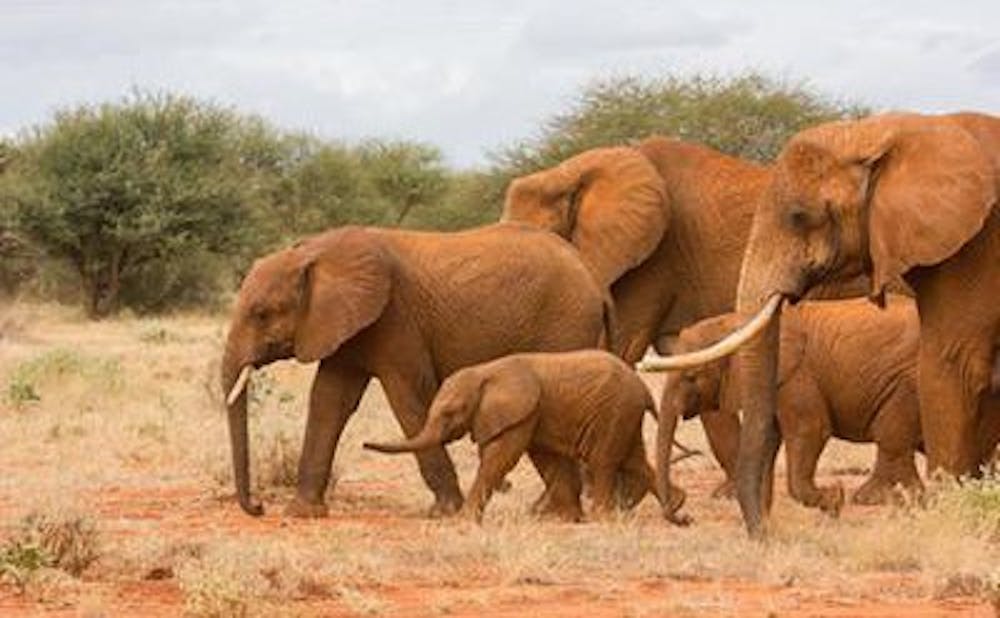Under the thick forest canopies of three national parks across the Central African country of Gabon, 34 forest elephants wear satellite collars.
The collars provide data that John Poulsen, an assistant professor of tropical ecology in the Nicholas School of the Environment, and the Forest Elephant Working Group are analyzing to understand where and why these elephants move. Doing so, the researchers expect, will help identify areas that the Gabon Park Agency can better protect in order to curb the rapid decline of the forest elephants from poaching.
“In the last decade, there has been a real poaching crisis for forest elephants, and they are essentially being wiped out,” Poulson said. “I decided that we needed to focus a lot more attention on forest elephants before it was too late.”
Poulsen explained that he formed the FEWG in 2014 in response to reports that 62 percent of forest elephants across Central Africa had been exterminated due to poaching from 2001 to 2011.
One of their first challenges was accurately quantifying the problem, he said.
They first took a census of the forest elephant population in Minkébé National Park in the northeastern corner of Gabon, an area that was thought to have the densest population of forest elephants in Central Africa. They were able to gain an approximate count of the elephants and compare their findings with a 2004 census of the park through observing elephants and their dung, explained Cooper Rosin, a member of the FEWG and a fourth-year Ph.D. candidate in the Nicholas School.
“One of the main things the FEWG did was to analyze this data and write it up, and it was accepted into [the journal] Current Biology recently,” Poulsen said. “What we found is that between 2004 and 2014, the park lost 81 percent of its elephants, mostly to ivory poachers coming from Cameroon.”
Rosin said these statistics suggest that around 25,000 elephants were lost to poachers throughout the decade.
“Our work is highlighting what a strong effect poaching can have, even in the most remote and large protected areas,” Rosin said. “Intergovernmental solutions are really necessary to protect the elephants there.”
Poulsen noted that their paper in Current Biology pushes for the recognition of forest elephants as a separate species from savanna elephants.
“There is really strong behavioral, phenotypic and genotypic evidence that they should be designated as a separate species, but for some political reasons they have not,” Rosin said. “When savanna elephants are doing well in some parks, that relieves the urgency to protect forest elephants elsewhere, and forest elephants are really suffering.”
The FEWG is using a number of innovative solutions to address the crisis, including the satellite collars.
The 34 collars that are currently being used were implemented in two “collaring campaigns” in October 2015 and April 2016 through a partnership with the Gabon Park Agency, and the group intends to add 24 more in the spring of this year, Poulsen explained.
“The cool thing about this project is that we are going to have the most collared elephants throughout Central Africa. We are doing this in three different national parks,” he said. “We think that with this big of a sample size we will really be able to figure out what drives elephants and why they move and how big their home range is.”
By potentially identifying the regions where the forest elephants need more protection, the group hopes to help the Gabon Park Agency efficiently distribute its protective resources to provide the best protection possible for the animals.
Another method that the team has experimented with—and plans to expand—is drones.
Poulsen said that he approached Mary Cummings, a professor of mechanical engineering and material sciences, about developing the technology.
“My big goal was to be able to use drones to fly over the forest and use infrared technology to see elephants under the canopy so that we can census them in a very precise and accurate way,” Poulsen said. “But she told me that it turns out that there is no technology yet that will allow us to see elephants under the canopy.”
In January 2016, Poulsen, Cummings and three of Cummings' students tested out drones to survey the elephants at more exposed sites such as watering holes, but the rough conditions of the African savanna caused the drones to quickly fall apart. Poulsen noted that they are still working on the idea and intend to use higher quality materials.
Amelia Meier, a member of FEWG and a Ph.D. student in the Nicholas School, has recently landed back in Gabon, where she will spend the next two months training volunteers to collect genetic samples from feces of the elephants.
“I’m trying to indirectly study their behavior through this genetic analysis,” she said.
Despite the dramatic decline in the population of forest elephants in recent years, members of the FEWG see reasons to be hopeful.
Poulsen cited China’s recent announcement that it will ban the ivory trade within the country as progress, and said that he thinks it came about because of a greater awareness of the decline of elephants across Africa.
“Our data and our findings probably contributed to the knowledge of the elephants that accumulated the pressure on China, but didn’t specifically do it,” he said. “I think our data is going to be a lot more important for helping the Gabon Parks Agency protect their elephants, potentially developing protected corridors, for understanding when and how elephants move and understanding the major loss of elephants in the Minkébé Park area.”
Get The Chronicle straight to your inbox
Signup for our weekly newsletter. Cancel at any time.
Bre is a senior political science major from South Carolina, and she is the current video editor, special projects editor and recruitment chair for The Chronicle. She is also an associate photography editor and an investigations editor. Previously, she was the editor-in-chief and local and national news department head.
Twitter: @brebradham
Email: breanna.bradham@duke.edu

